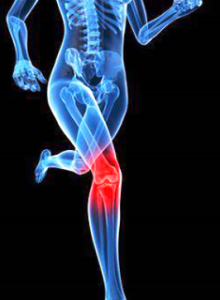Patella femoral pain syndrome
Patella femoral pain syndrome (Runner’s Knee)
Patellofemoral pain (patellofemoral pain syndrome) refers to the pain that is felt at the front and around of the patella (kneecap). Patients most commonly report a dull ache at the patella region that is increased with running, squatting, jumping, stair climbing or activities that involve knee flexion. Pain can be typically worse with activity or sitting for long periods of time with grinding feeling or noise felt when the knee moves (crepitus).
Poor biomechanics, is the major cause of patellofemoral injury. The most common mechanical problem is over pronation (flat feet). Over pronation increasing frictional stress under the patella causing inflammation. This occurs because the patella is not running smoothly within the femoral groove at the angle at the knee (called the Q angle) is increased. This is far more common in women runners as due to the hip anatomy female athletes have an increased Q angle. Other causes of patellofemoral injury include;
- Muscle imbalance (Tight muscles groups) – If posterior muscles such as calf muscles and hamstrings are tight extra, stress is placed on the knee as it does not fully extend through the gait cycle. Additionally weak muscles not providing stability to the knee can also lead to this injury.
- Increased frequency (how often you exercise), duration (how long you exercise) and intensity (your level of exercise).
- Running style and running on hard or uneven surfaces.
- Worn footwear is also a major contributory factor. If the shoe is not doing its job of providing both stability and shock absorbency then ground reaction force will be transferred to the knee increasing the chances of patellofemoral problems occurring.
Treatment
The podiatrist will obtain a comprehensive history of symptoms and perform a biomechanical assessment identifying the cause of the pain. Diagnostic imaging including an X-ray and Ultrasound may be prescribed by the podiatrist for further review of the painful area. At Sydney Foot Clinic some conservative treatment modalities include;
- Rest – avoid activities that worsen the symptoms (squatting, jumping, and bending the knee).
- Ice and Nonsteroidal Anti-inflammatory drugs (NSAIDS) – this will help reduce the pain and inflammation.
- Footwear recommendations.
- Training modifications.
- Custom prescription orthotic therapy – orthotics may be prescribed to address any biomechanical factors such as over pronation (flat feet).

